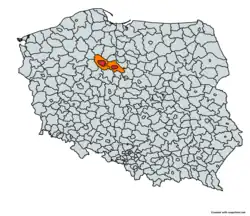Bydgoszcz–Toruń metropolitan area
aglomeracja bydgosko-toruńska | |
|---|---|
Urban area | |
 Skyline of Bydgoszcz | |
 | |
| Country | |
| Region | |
| Largest city | Bydgoszcz |
| Area | |
| • Metro | 2,917 km2 (1,126 sq mi) |
| Population | |
| • Metro | 752,655 |
| • Metro density | 260/km2 (670/sq mi) |
| GDP | |
| • Metro | €10.871 billion (2020) |
| Time zone | UTC+1 (CET) |
Bydgoszcz–Toruń metropolitan area (Polish: aglomeracja bydgosko-toruńska) is the name of the bi-polar agglomeration in the middle of the Vistula river created by 2 cities: Bydgoszcz and Toruń. The distance between the built-up areas of the cities is about 30 km. They are the administrative capitals and economic center of Kuyavian-Pomeranian Voivodship.

- Bydgoszcz–Toruń metropolitan area according to KPBPPiR
- Bydgoszcz–Toruń metropolitan area according to P. Swianiewicz and U. Klimska
- Both conceptions
Despite the fact that these two cities are integrating gradually, they have been in a great competition through the centuries. In September 2004 the Medical Academy in Bydgoszcz joined Toruń University as Collegium Medicum in Bydgoszcz. Although not without some controversy, this is usually considered as an important step in the integration process.
Depending on the calculation method and on what is the exact area taken into consideration, the total population varies from between about 600,000 and 800,000 inhabitants.
See also
References
- ↑ GUS. "Population. Size and structure and vital statistics in Poland by territorial division in 2019. As of 30th June". stat.gov.pl. Retrieved 2020-09-11.
- ↑ "Gross domestic product (GDP) at current market prices by NUTS 3 regions". ec.europa.eu.